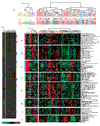Molecular profiling of breast cancer: portraits but not physiognomy
- PMID: 11250749
- PMCID: PMC138674
- DOI: 10.1186/bcr274
Molecular profiling of breast cancer: portraits but not physiognomy
Abstract
Breast cancers differ in response to treatment and may have a divergent clinical course despite having a similar histopathological appearance. New technology using DNA microarrays provides a systematic method to identify key markers for prognosis and treatment response by profiling thousands of genes expressed in a single cancer. Microarray profiling of 38 invasive breast cancers now confirms striking molecular differences between ductal carcinoma specimens and suggests a new classification for oestrogen-receptor negative breast cancer. Future approaches will need to include methods for high-throughput clinical validation and the ability to analyze microscopic samples.
Figures

Similar articles
-
Profiling familial breast cancer.Nat Med. 2001 Apr;7(4):408-10. doi: 10.1038/86464. Nat Med. 2001. PMID: 11283660 No abstract available.
-
Influence of BRCA1 mutations on nuclear grade and estrogen receptor status of breast carcinoma in Ashkenazi Jewish women.Cancer. 1997 Aug 1;80(3):435-41. doi: 10.1002/(sici)1097-0142(19970801)80:3<435::aid-cncr11>3.0.co;2-y. Cancer. 1997. PMID: 9241077
-
RERG (Ras-like, oestrogen-regulated, growth-inhibitor) expression in breast cancer: a marker of ER-positive luminal-like subtype.Breast Cancer Res Treat. 2011 Jul;128(2):315-26. doi: 10.1007/s10549-010-1073-y. Epub 2010 Aug 10. Breast Cancer Res Treat. 2011. PMID: 20697807
-
Gene expression profiling of breast cancer.Annu Rev Pathol. 2008;3:67-97. doi: 10.1146/annurev.pathmechdis.3.121806.151505. Annu Rev Pathol. 2008. PMID: 18039137 Review.
-
Applications of microarray technology in breast cancer research.Breast Cancer Res. 2001;3(3):158-75. doi: 10.1186/bcr291. Epub 2001 Mar 20. Breast Cancer Res. 2001. PMID: 11305951 Free PMC article. Review.
Cited by
-
Microarray gene expression profiling and analysis in renal cell carcinoma.BMC Urol. 2004 Jun 22;4:9. doi: 10.1186/1471-2490-4-9. BMC Urol. 2004. PMID: 15212686 Free PMC article.
-
Embryonic reversions and lineage infidelities in tumour cells: genome-based models and role of genetic instability.Int J Exp Pathol. 2005 Apr;86(2):67-79. doi: 10.1111/j.0959-9673.2005.00421.x. Int J Exp Pathol. 2005. PMID: 15810978 Free PMC article. Review.
-
Knockdown of TFIIS by RNA silencing inhibits cancer cell proliferation and induces apoptosis.BMC Cancer. 2008 May 12;8:133. doi: 10.1186/1471-2407-8-133. BMC Cancer. 2008. PMID: 18474089 Free PMC article.
-
DNA microarrays with stem-loop DNA probes: preparation and applications.Nucleic Acids Res. 2001 Oct 1;29(19):E92. doi: 10.1093/nar/29.19.e92. Nucleic Acids Res. 2001. PMID: 11574694 Free PMC article.
-
Analysis of multiple sarcoma expression datasets: implications for classification, oncogenic pathway activation and chemotherapy resistance.PLoS One. 2010 Apr 1;5(4):e9747. doi: 10.1371/journal.pone.0009747. PLoS One. 2010. PMID: 20368975 Free PMC article.
References
-
- Perou CM, Sorlie T, Eisen MB, van de Rijn M, Jeffrey SS, Rees CA, Pollack JR, Ross DT, Johnsen H, Akslen LA, Fluge O, Pergamenschikov A, Williams C, Zhu SX, Lonning PE, Borresen-Dale AL, Brown PO, Botstein D. Molecular portraits of human breast tumours. Nature. 2000;406:747–752. doi: 10.1038/35021093. - DOI - PubMed
-
- Alizadeh AA, Eisen MB, Davis RE, Ma C, Lossos IS, Rosenwald A, Boldrick JC, Sabet H, Tran T, Yu X, Powell JI, Yang L, Marti GE, Moore T, Hudson J, Jr, Lu L, Lewis DB, Tibshirani R, Sherlock G, Chan WC, Greiner TC, Weisenburger DD, Armitage JO, Warnke R, Staudt LM. Distinct types of diffuse large B-cell lymphoma identified by gene expression profiling. Nature. 2000;403:503–511. doi: 10.1038/35000501. - DOI - PubMed
-
- Bittner M, Meltzer P, Chen Y, Jiang Y, Seftor E, Hendrix M, Radmacher M, Simon R, Yakhini Z, Ben-Dor A, Sampas N, Dougherty E, Wang E, Marincola F, Gooden C, Lueders J, Glatfelter A, Pollock P, Carpten J, Gillanders E, Leja D, Dietrich K, Beaudry C, Berens M, Alberts D, Sondak V. Molecular classification of cutaneous malignant melanoma by gene expression profiling. Nature. 2000;406:536–540. doi: 10.1038/35020115. - DOI - PubMed
Publication types
MeSH terms
Substances
LinkOut - more resources
Full Text Sources
Other Literature Sources
Medical

